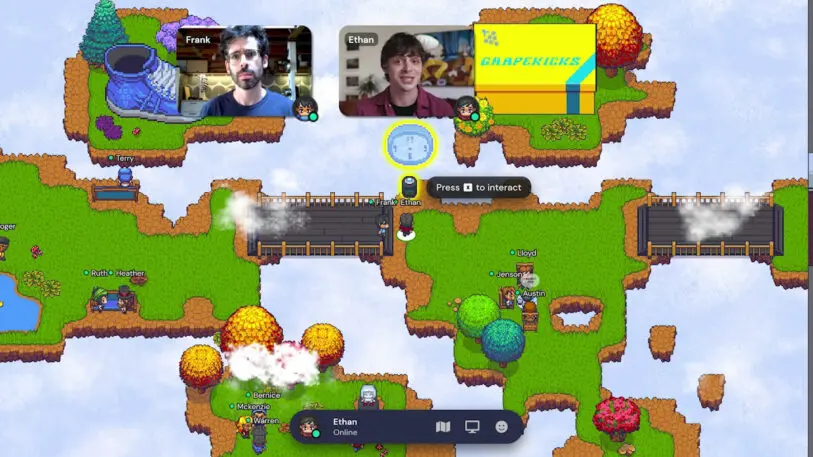On a recent tour of company headquarters, Gather founder and CEO Phillip Wang showed off some of the typical tech office attractions: plenty of conference rooms for private meetings, places to relax or have spontaneous conversations with coworkers, a secure area only unlockable by employees, and even a scenic roof deck. Some employees having a client meeting stopped to wave as we passed by.
What made the tour unusual was that Wang and I weren’t in the same place, nor was he strolling through the office with a camera. Instead, Gather headquarters is inside the environment built by the company, which provides virtual gathering places for businesses, individual socialization, and events like conferences, performances, and festivals.
“It’s actually the only headquarters we ever had,” Wang says. “The way that we use our office is just as you would use any real life office.”
Gather environments, which can be customized by users building their own spaces, often from provided templates, have a pixel art vibe reminiscent of old Final Fantasy video games or the intro to HBO’s Silicon Valley. In addition to offices, the platform has been used to host escape rooms and murder mystery games, a major artificial intelligence conference, a launch event for a new set of “Magic: the Gathering” cards, and an immersive fortune-telling theater show. It’s also been used for family birthday parties, including by one septuagenarian who asked the company for a little help setting up the virtual space for her family, and by churches looking to build online houses of worship.

“You could create a whole event venue in just an hour or two,” says Wang. “How long it takes to create is really up to how crazy you want to make the map look.”
He sees the platform as part of the growing trend towards building a metaverse—a somewhat nebulous term that generally refers to building an online gathering space that feels like a digital, interactive world—but says the company wants to do things differently than some of the big companies in the area. Specifically, he says, Gather wants to shy away from the ad-supported models that have long funded online and social media services in order to keep the company more aligned with what users want. He also wants to see the platform be interoperable with other metaverse providers through open standards like those that power email and the web, rather than building a walled garden like many of today’s social networking and messaging platforms do (this feature is not yet available).

The company will likely face stiff competition from established tech giants like Facebook (which just changed its parent company name to Meta to emphasize its metaverse ambitions). Microsoft also just announced its own metaverse plans, including integrating its Mesh platform with its Teams communication software. Similar to Gather, Microsoft will potentially enable other metaverse providers to connect with it.

“The marketing word that I would put to it is unstructured interactions,” says Pat Grady, a partner at Sequoia Capital and an investor in Gather, which raised a total of $77 million in Series A and B rounds this year. “If you are working with your team in Gather, it is totally accessible to wander over to the kitchen and strike up a conversation with whomever happens to be there.”
The platform also provides capabilities for video chat, making presentations, and sharing files like Google Documents. Wang anticipates that in the future, Gather will add more features, potentially including a broader virtual world so that people could, say, walk out of their offices and find themselves in a virtual town. But, he says, the company is committed to keeping the platform accessible to a wide swath of users, even as technology evolves.
“We chose a visual style that was easy for people to use,” he says.
Recognize your brand’s excellence by applying to this year’s Brands That Matter Awards before the early-rate deadline, May 3.
